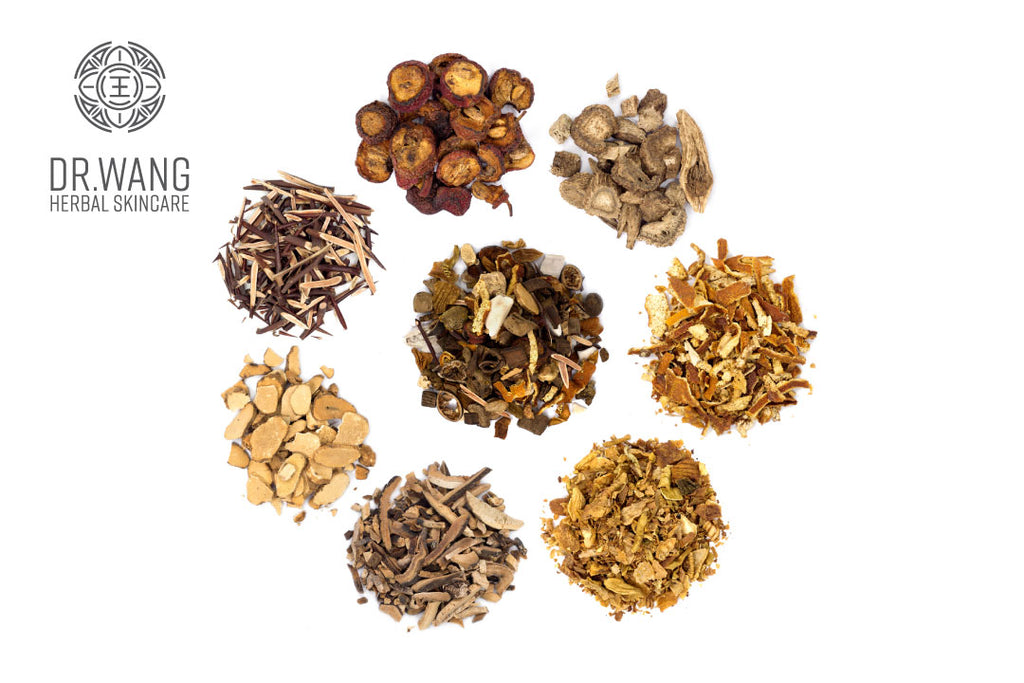The 50 Fundamental Herbs of Traditional Chinese Medicine
Developed over 3,000 years ago, Traditional Chinese Medicine, or TCM, incorporates a holistic approach to healing and health. The practice goes beyond a mindset of just simply treating a list of symptoms. It goes deeper than even the underlying disease processes and looks to the heart of the matter: the balance, ebb, and flow of energy through the body’s natural pathways.
Through the course of treatment, practitioners incorporate diet, cupping, qigong, herbs, and acupuncture to bring things into alignment, naturally treating and preventing health problems.
Herbs are a mainstay of the practice, and the precise way in which they are formulated and mixed together is completely dependent upon a whole host of qualifications of the patient, taking into account all body systems, healthy and otherwise. The herbs can be administered in a variety of ways, depending on the problem being remedied and the function of the herb itself. Some may be taken orally as teas, tinctures, or capsules. Others may be applied topically as poultices or rubs, while others may be burned and used as a drawing agent.
Below are 50 of TCM’s most fundamental herbs and a bit about their use in TCM.
1. Agastache rugosa - huòxiāng (藿香)
Also known as Korean mint, this is used to transform dampness that is obstructing the stomach and spleen, harmonize the Middle Warmer, and relieve the Exterior from invasion of Cold and Damp.
- Abdominal bloating
- Abdominal pain
- Loss of appetite
- Morning sickness
- Vomiting
2. Alangium chinense - bā jiǎo fēng (八角枫)
The Chinese Alangium Root is used to dispel Wind, eliminate Dampness, relax the tendons and bones, dissipate stasis and alleviate pain.
- Numb limbs
- Rheumatic arthritis
- Traumatic injury
3. Anemone or Pulsatilla chinensis - bái tóu weng (白头翁)
Chinese anemone is used to clear Heat, remove toxins, and reduce inflammation.
- Amoebic or bacterial dysentery
- Epistaxis and bleeding hemorrhoids
- Trichomonas vaginitis
4. Anisodus tanguticus - shān làngdàng (山莨菪)
Mountain henbane contains high levels of tropane alkaloids hyoscyamine and scopalamine which act as anticholinergics, stabilizing the circulatory system during shock.
- Shock
- Vasospasm
5. Ardisia japonica - zǐjīn niú (紫金牛)
The marlberry expels phlegm, invigorates Blood, and clears some infections.
- Cough suppressant
- Alleviates bruising
- Regulates menstrual flow
- Jaundice
- Difficulty urinating
6. Aster tataricus - zǐwǎn (紫菀)
The aster has antibacterial and antifungal properties and has been used as a folk cure for cancer.
- Antibacterial
- Antifungal
- Antitussive
- Cancer
- Expectorant
7. Astragalus membranaceus - huángqí (黄芪) or běiqí (北芪)
Milkvetch rebalances and replenishes the qi of the spleen and stomach, and tonifies and nourishes the qi and blood.
- Anti-inflammatory
- Blood sugar
- Cancer
- Cardiac health
- Chemotherapy
- Immune stimulant
- Kidney function

8. Camellia sinensis - chá shù (茶树) or chá yè (茶叶)
A favorite for its delicious tea and antioxidant properties, green tea is used to move the qi down if it’s stuck and aids in urine retention, clears Phlegm, and cools internal Heat.
- Pruritus
- Clear phlegm
- Thirst
- Aid fatigue
- Aid constipation
- Skin fungus
- Fight hunger
- Longevity
9. Cannabis sativa - dà má (大麻)
Marijuana has been used for hundreds of years and has numerous medical uses prescribed by TCM.
- Dry cough
- Asthma
- Calming nerves
- Insomnia
- Pain
- Prevent brain damage after injury
- Dry stool
- Promote urination
10. Carthamus tinctorius - hóng huā (红花)
Safflower is used to invigorate the blood. Can regulate menses.
- Amenorrhea
- Dysmenorrhea
- Sores
- Carbuncles
- Abdominal masses
11. Cinnamomum cassia - ròu gùi (肉桂)
Cinnamon can reduce glucose and cholesterol in people with type 2 diabetes.
- Digestive upsets
- Antibacterial
- Diarrhea
12. Cissampelos pareira - xí shēng téng (锡生藤) or (亞乎奴)
- Asthma
- Cough
- Fever
- Arthritis
- Obesity
- Dysentery
- Snakebite
- Jaundice
- Heart problems
- Blood pressure
- Skin-related problems
13. Coptis chinensis - duǎn è huánglián (短萼黄连)
Chinese Goldthread is used to treat the gastrointestinal parasite, Blastocystis hominis.
14. Corydalis ambigua - yán hú suǒ (延胡索)
Chemical derivatives of fumewort have been studied as potential ways to increase pain tolerance and for treating drug addiction.
- Anxiolytic
- Sedative
15. Croton tiglium - bā dòu (巴豆)
As its common name tells all, Purging Croton is used as a strong purgative.
16. Daphne genkwa - yuánhuā (芫花)
A known poison, the flower buds and roots are used for a variety of reasons.
- Control cough
- Anticoagulant
- Antiseptic
- Antitussive
- Antiviral
- Diuretic
- Purgative
- Stomachic
- Bronchitis
- Constipation
- Oedema
- Skin diseases
- Frostbite
- Abortifacient
- Vesicant
17. Datura metel - yáng jīn huā (洋金花)
Also known as Devil’s Trumpet or White thornapple.
- Calm asthma
- Stop cough
- Relieve pain
- Anesthetize
18. Datura stramonium - zǐ huā màn tuó luó (紫花曼陀萝)
Jimsonweed or devil’s snare is another member of the nightshade family. It contains tropane alkaloids which produce hallucinogenic properties. It was once used by the Chinese as a form of anesthesia during surgeries.
19. Dendrobium nobile - shí hú (石斛) or shí hú lán (石斛兰)
Noble Dendrobium is used to tonify the yin of the Lung and Stomach and help in generation of Fluids. It clears Heat and nourishes the Yin, Improves vision and strengthens the lower back.
- Loss of appetite
- Fever
- Impaired vision
- Hematemesis
- Excessive thirst

20. Dichroa febrifuga - chángshān (常山)
The Evergreen Hydrangea has been used to treat malaria in China for over 2,000 years.
- Antimalarial
- Expectorant
- Emetic
- Sputum loosener
21. Ephedra sinica - cǎo má huáng (草麻黄)
Chinese ephedra has been used for centuries, as well.
- Stimulate brain
- Increase heart rate
- Constrict blood vessels
- Expand bronchial tubes
- Increase metabolism
22. Eucommia ulmoides - dùzhòng (杜仲)
The Hardy Rubber Tree is used to treat cardiovascular and cerebrovascular diseases, sexual dysfunction, cancers, metabolic syndrome, and neurologic diseases.
- Antioxidant
- Anti-inflammatory
- Antiallergic
- Antimicrobial
- Anticancer
- Anti-aging
- Cardioprotective
- Neuroprotective
23. Euphorbia pekinensis - dàjǐ (大戟)
Prescribed for more serious diseases, Peking spurge is used as a cathartic to purge excess fluids in conditions like pleurisy and ascites and for treatment of kidney problems like nephritis.
- Antibacterial
- Diuretic
- Emetic
- Emmenagogue
- Purgative
- Vasodilator
24. Flueggea suffruticosa (formerly Securinega suffruticosa) - yī yè qiū (一叶秋)
This is often used as a central nervous system stimulant.
25. Forsythia suspensa - liánqiào (连翘)
Weeping forsythia has been used in the treatment of bacterial infections and upper respiratory ailments.
- Antipyretic
- Anti-inflammatory
- Diuretic
- Cardiovascular tonic
26. Gentiana loureiroi - dì dīng (地丁)
This is used to clear hear and counteract toxic effects.
- Carbuncle
- Swelling
- Boils

27. Gleditsia sinensis - zào jiá (皂荚)
The Chinese honey locust is used to treat several conditions related to Phlegm accumulation.
- Cough
- Wheezing
- Sputum
- Abscesses
- Boils
- Constipation due to roundworms
- Stimulate metabolism
28. Glycyrrhiza uralensis - gāncǎo (甘草)
Licorice works to tonify spleen qi, moisten lung, clear heat, and tonify heart qi.
- Dry cough
- Regulate pulse
- Alleviate spasmodic pain
29. Hydnocarpus anthelmintica (syn. H. anthelminthicus) - dà fēng zǐ (大风子)
The Chaulmoogra tree is used to dry excess damp and to kill and expel worms.
- Leprosy
- Scabies
- Syphilitic ulcers
30. Ilex purpurea - dōngqīng (冬青)
Purple holly has been used to treat coronary disease for centuries.
31. Leonurus japonicus - yìmǔcǎo (益母草)
Chinese motherwort has been used for over 1800 years as a treatment for menstrual and delivery disorders caused by blood stasis.
- Dysmenorrhea Amenorrhea
- Postpartum hemorrhage
32. Ligusticum wallichii - chuānxiōng (川芎)
Szechwan lovage has been used extensively for cardiovascular and cerebrovascular diseases.
- Irregular menstruation
- Amenorrhea
- Dysmenorrhea
- Chest pain
- Headache
- Arthralgia
33. Lobelia chinensis - bàn biān lián (半边莲)
Creeping lobelia clears heat toxicity and induces diuresis.
- Venomous snake bite
- Furuncle
- Carbuncle
- Tonsillitis
- Eczema
- Athlete’s foot
- Traumatic injury
- Dampness-heat jaundice
- Appendicitis
- Enteritis
- Nephritis
- Ascites due to cirrhosis
- Many types of cancer

34. Phellodendron amurense - huáng bǎi (黄柏)
The Amur cork tree cools upper burner blood heat to soothe ulcers of the mouth and tongue.
35. Platycladus orientalis (formerly Thuja orientalis) - cèbǎi (侧柏)
Seeds of the Chinese arborvitae are used.
- Settle irritability
- Insomnia
- Forgetfulness
- Palpitations
- Anxiety
- Night sweats
- Constipation
- Bloody stools
- Treat cancer
- Menstrual issues
36. Pseudolarix amabilis - jīn qián sōng (金钱松)
Golden larch is used as a dermatologic antifungal remedy.
37. Psilopeganum sinense - shān má huáng (山麻黄)
On the brink of extinction, Naked rue is rarely used these days and you’ll be hard-pressed to find it.
38. Pueraria lobata - gé gēn (葛根)
Kudzu now grows as an out-of control introduced weed all over Southern United States.
- Fever
- Headache
- Stiff or tight upper back and neck
- Quench thirst
- Vent measles
- Stop diarrhea
- Hypertension
39. Rauwolfia serpentina - (從蛇根木) or (印度蛇木)
Known as Indian Snakeroot.
- Hypertension
- Agitated psychotic states
40. Rehmannia glutinosa - dìhuáng (地黄) or gān dìhuáng (干地黄)
Ehmannia clears heat, cools blood, nourishes yin, generates fluids, treats wasting and thirsting disorder.
- Anemia
- Dizziness
- Constipation

41. Rheum officinale - yào yòng dà huáng (药用大黄)
Rhubarb is used to purge accumulation, cool blood, invigorate blood, and drain damp-heat.
- Diarrhea
- Anti-bacterial
- Anti-bleeding
- Lower lipids
- Lower blood pressure
- Anti-tumor
- Laxative
42. Rhododendron tsinghaiense - Qīnghǎi dùjuān (青海杜鹃)
- Anti-inflammatory
- Hepatoprotective
- Antioxidant
43. Saussurea costus - yún mù xiāng (云木香)
Costus is used to regulate qi.
- Abdominal pain
- Abdominal bloating
- Vomiting
- Diarrhea
44. Schisandra chinensis - wǔ wèi zi (五味子)
Berries from the Chinese magnolia vine are used to stabilize and bind.
- Dyspnea
- Spermatorrhea
- Enuresis
- Urinary incontinence
- Night sweats
- Diabetes
- Insomnia
- Palpitations
- Vaginal discharge
- Dry cough
- Asthma
45. Scutellaria baicalensis - huángqín (黄芩)
Also known as skullcap.
- Diarrhea
- Dysentery
- Hypertension
- Hemorrhaging
- Insomnia
- Inflammation
- Respiratory infections
- Anti-cancer
- Hepatoprotection
- Antibacterial
- Antiviral
- Antioxidant
- Anticonvulsant
- Neuroprotective
46. Stemona tuberosa - bǎi bù (百部)
Used to relieve cough and destroy intestinal worms.
- Pulmonary tuberculosis
- Head lice
- Ring worm
- Intestinal parasites
- Epidemic diseases
47. Stephania tetrandra - fáng jǐ (防己)
Stephania can encourage urination, allay pain and dispel wind-damp painful obstruction.
- Edema
- Oliguria
- Eczema
- Rheumatoid arthritis
- Hypertension

48. Styphnolobium japonicum (formerly Sophora japonica) - huái (槐), huái shù (槐树), or huái huā (槐花)
The Japanese pagoda tree regulates and cools blood.
- Hemorrhoids
- Hematemesis
- Hemafecia
- Hemoptysis
- Epistaxis
- Bloody dysentery
- Red eyes
- Hypertension
- Conjunctivitis
- Nervous agitation
- Dizziness
- Moist pruritus of genitals
- Metrorrhagia
49. Trichosanthes kirilowii - guālóu (栝楼)
The Chinese cucumber is used as a tonic.
- Cough with thick phlegm
- Relieve sensations of pressure in chest
- Abscesses of breasts and lungs
- Antibiotic
- Anti-cancer
50. Wikstroemia indica - liǎo gē wáng (了哥王)
Indian stingbush is used to heal inflammation, stimulate circulation, and promote diuresis.
- Swellings
- Abscesses
- Enlarged cervical nodes
- Lymphnoiditis
- Mastitis
- Mumps
- Fungal infections of the scalp
- Asthma
- Bronchitis
- Pneumonia
- Snake and insect bites
- Traumatic injuries
Quite the exhaustive list! These 50 herbs have been used for centuries by Traditional Chinese Medicine doctors, and Western medicine is only just beginning to understand what these herbs have to offer. Many of these are used for the treatment of skin ailments and to help heal wounds.
Steven Wang, MD and Gui Wang, LAc have been working together for over 20 years to provide potent, herbal remedies for spas and individuals around the world. The father-son duo mixes Traditional Chinese Medicine (TCM) with cutting edge scientific advances with the aim of bringing relief, comfort, and happiness to our customers. Our products are the result of decades of dedicated research.
We believe that utilizing both modern Western medicine and time-honored Eastern medicine allows us to provide unique skincare solutions. To learn more, read what experts from The New York Times, Allure, Reader’s Digest, and more have to say about our revolutionary products.




